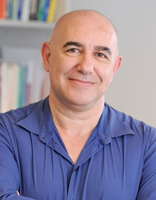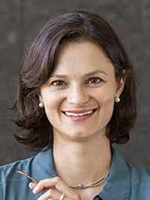Program
-
FOSBE 2019 will consist of more than a hundred contributions from all over the world. Five plenaries and keynotes will complement oral and poster contributions.
Detailed technical program
Conference booklet pdf (NEW)
Invited speakers
The FOSBE program will feature two plenaries by distinguished researchers at the interface of systems biology and automatic control. There will be also four invited keynote speakers, two from academia and two from the industry.
Confirmed plenary speakers
- Mustafa Khammash, Dept. of Biosystems Science & Engineering, ETH Zurich.
A single biomolecular controller topology achieves Robust Perfect Adaptation for arbitrary intracellular networks with noisy dynamics. - Ines Thiele, School of Medicine, National University of Ireland, Galway.
Computational modeling of whole-body metabolism permits novel insight into host-microbiome co-metabolism.
Confirmed keynote speakers
- Neda Bagheri, Department of Biology and Chemical Engineering, University of Washington.
Modelling for systems medicine. - Stephan Schaller, Founder and CEO, esqLABS GmbH.
Never lost in translation: How systems pharmacology can bridge from early research to proof-of-concept in humans. - Alexander Hoffmann, Institute for Quantitative and Computational Biosciences, University of California, Los Angeles.
Understanding biological function in the context of biological heterogeneity - Daniel Georgiev, Founder and CEO, XENO Cell Innovations.
Small multicellular cohorts are engineered to function as a distributed detector of rare multivariate events
Plenary Talks Abstracts

Mustafa Khammash, Dept. of Biosystems Science & Engineering, ETH Zurich.
A single biomolecular controller topology achieves Robust Perfect Adaptation for arbitrary intracellular networks with noisy dynamics.Homeostasis is a recurring theme across living systems. Homeostatic mechanisms frequently ensure that regulated variables robustly and fully adapt to environmental perturbations. This robust perfect adaptation (RPA) feature is achieved by incorporating mathematical integration in a negative feedback strategy. Despite its benefits in natural circuits, the synthetic realization of integral feedback has remained elusive due to the complexity of the required biological computations. In this talk, I will show that there is fundamentally a single biomolecular controller topology that realizes integral feedback for arbitrary intracellular networks with noisy dynamics. Such a controller ensures robust perfect adaptation for the cell population- average as well as for the time-average of single cells. I will then present the first synthetic gene network implementation of such an integral controller in a living cell, and demonstrate its tunability and adaptation properties. Finally, I will highlight the genetic controller’s versatility by discussing its application to population growth control.

Ines Thiele, School of Medicine, National University of Ireland, Galway.
Computational modeling of whole-body metabolism permits novel insight into host-microbiome co-metabolism.Precision medicine relies on the availability of realistic, mechanistic models that capture the complexity of the human body. Comprehensive computational models of human metabolism have been assembled by the systems biology community, which summarize known metabolic processes occurring in at least one human cell or organ. However, these models have not yet been expanded to connect with whole-body level processes. To address this shortcoming, we built whole-body metabolic models of a male (deemed Harvey) and a female (deemed Harvetta) starting from the existing human metabolic models, physiological and anatomic information, comprehensive proteomic and metabolomic data, as well as biochemical data obtained from an extensive manual literature review. We tested the predictive capabilities of the resulting whole-body metabolic models against the current knowledge of organ-specific and inter-organ metabolism. The final models contain 28 organs. Importantly, these whole-body models can be expanded to include the strain-resolved metabolic models of gut microbes. By parameterizing the whole-body metabolic models with physiological and metabolomic data, we connected physiology with molecular-level processes through networks of genes, proteins, and biochemical reactions. As a sample application of the whole-body metabolic models, I will demonstrate how different microbial composition leads to differences in host metabolism, such as the capability to produce important neurotransmitters in the brain and flux through liver enzymes, with implications for the gut-brain axis as well as for microbiome-mediated liver toxicity. The predictions were consistent with our current understanding but also highlighted that different microbiota composition can lead to high inter-person variability. I envisage the microbiome-associated whole-body metabolic models will usher in a new era for research into causal host-microbiome relationships and greatly accelerate the development of targeted dietary and microbial intervention strategies.
Keynote Talks Abstracts

Neda Bagheri, Department of Biology and Chemical Engineering, University of Washington.
Modelling for systems medicine.
Computational models are essential tools that can be used to simultaneously explain and guide both biological and medical intuition. With increasingly high-resolution, high-throughput, and dynamic experimental data, computational biologists are better equipped to develop informed models that aim to characterize complex cellular responses and direct experimental design. My lab operates at this evolving interface between chemical engineering and biology; we employ machine learning, dynamical systems, and agent-based modeling strategies to help explain biological observations, and to elucidate design principles that drive both individual cellular decisions and cell populations. We are interested in the inherent multiscale nature of cells—how “the whole is greater than the sum of its parts”—and in predicting cell population dynamics from the composition of simpler biological modules to advance medicine.

Stephan Schaller, Founder and CEO, esqLABS GmbH.
Never lost in translation: How systems pharmacology can bridge from early research to proof-of-concept in humans.Quantitative, population-based simulations of clinical trials are usually conducted at later stages of drug development typically requiring clinical (human) data from Phase I/II/IIb of drug development. We have developed a digital platform, the Diabetes Platform within the OSP Suite (www.open-systems-pharmacology.com), for early prediction of clinical (trial) outcomes by leveraging physiological and systems-biology knowledge to translate early in-vitro and preclinical outcomes to the clinic. The Diabetes Platform applies a modular concept to allow efficient, flexible, and transparent multi-scale quantitative systems pharmacology (QSP) modeling and simulation. The software allows to combine cons of physiologically-based (PB) pharmacokinetic (PK) models (i.e. absorption, distribution, metabolization and excretion) of small and large molecules in different animal species and human populations with cellular-level systems-biology concepts to describe pharmacodynamic (PD) effects to create a physiologically- and mechanism-based translational modeling & simulation platform. The Diabetes Platform integrates subcellular mechanisms, such as islet biology, insulin secretion and -receptor dynamics across different animal species and human diabetes types and has been validated on various test scenarios with different treatment options, e.g. multiple insulin types, glucagon, GLP-1 and GIP analogues and SGLT1/2 inhibitors. The platform achieved high accuracy in describing the PK/PD of glucose, and respective treatments on both, the quantitative and the qualitative level. In conclusion, characterization of both the animal and human glucose metabolism on a structural and mechanistic level is of great value when new treatments need to be analyzed and translated during transition from research to development. The captured structural and mechanistic knowledge allows informed extrapolations and thus accurate predictions of the treatment PK, the mode of action concept and the effect (PD) on whole-body glucose metabolism when translating from animals to humans. Leveraging its PBPK and QSP framework and a population of characterized in-silico diabetes patients, the platform allows population-level in-silico first-in-man and proof-of-concept evaluations for conceptualized treatments of diabetes. This can be done by translation of either pre-clinical outcome data or in-vitro compound properties at the drug discovery or lead-optimization stage.

Alexander Hoffmann, Institute for Quantitative and Computational Biosciences, University of California, Los Angeles.
Understanding biological function in the context of biological heterogeneityBiological heterogeneity is a hallmark of biomedicine at any level, whether patients diagnosed with the same cancer but showing differential treatment success, fate decisions by genetically identical cells, or the signaling dynamics of immune cells responding to pathogens or cytokines. We have employed computational modeling of cellular responses and the underlying molecular network to understand the sources of biological heterogeneity and learn about biological function. Combining data-driven and knowledge-based modeling approaches
has allowed us to quantify extrinsic and intrinsic noise sources, distinguish between static and dynamic network features that have predictive value and may function as prognostic biomarkers, and decipher the codewords of the language of immune sentinel cells. Overall, we find that biological function may emerge in different physiological contexts either because of or in spite of biological heterogeneity.

Daniel Georgiev, Founder and CEO, XENO Cell Innovations
Small multicellular cohorts are engineered to function as a distributed detector of rare multivariate eventsRare events, ipso facto, underlie early disease detection. Univariate rare events are standardly detected with highly specific molecular probes (e.g., antibodies or oligos). Routine detection of multivariate rare events is far more cumbersome. State-of-the-art solutions brute force the problem with high power instruments (e.g. flow cytometers or lab-on-chip devices). Not surprisingly, natural immune systems far outperform these solutions with distributed, hierarchical signal processing. The utility of these is however limited as the mechanisms remain concealed behind their biological complexity. This talk will present a solution currently being developed to product wherein microbial cohorts function as biocomputing units in detecting rare cells according to their multivariate surface profiles. Specific topics will include the lessons learned while addressing physical challenges inherent to multicellular signal processing within small cohorts of no more than one hundred individual cells. The ultimate hope of the talk is to use this commercially relevant case study to motivate benchmark problems in synthetic biology.
- Mustafa Khammash, Dept. of Biosystems Science & Engineering, ETH Zurich.


















